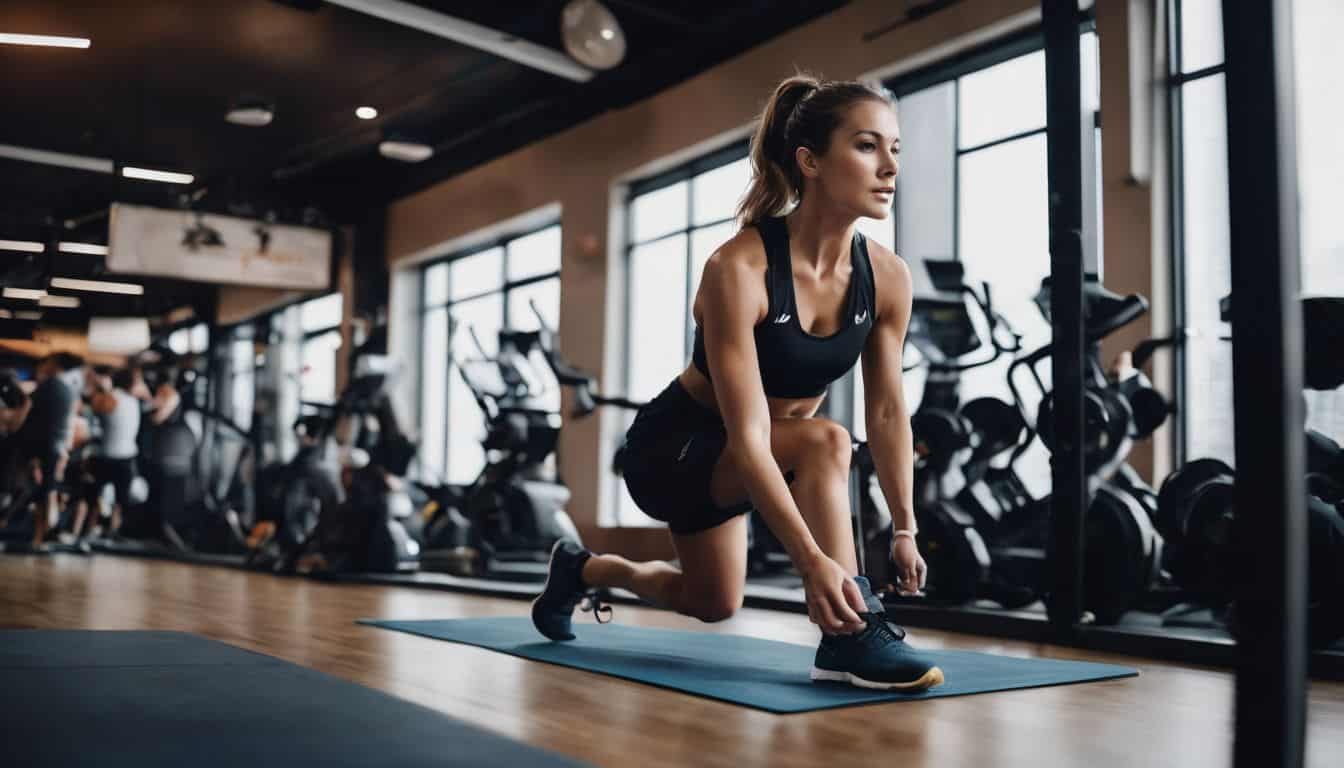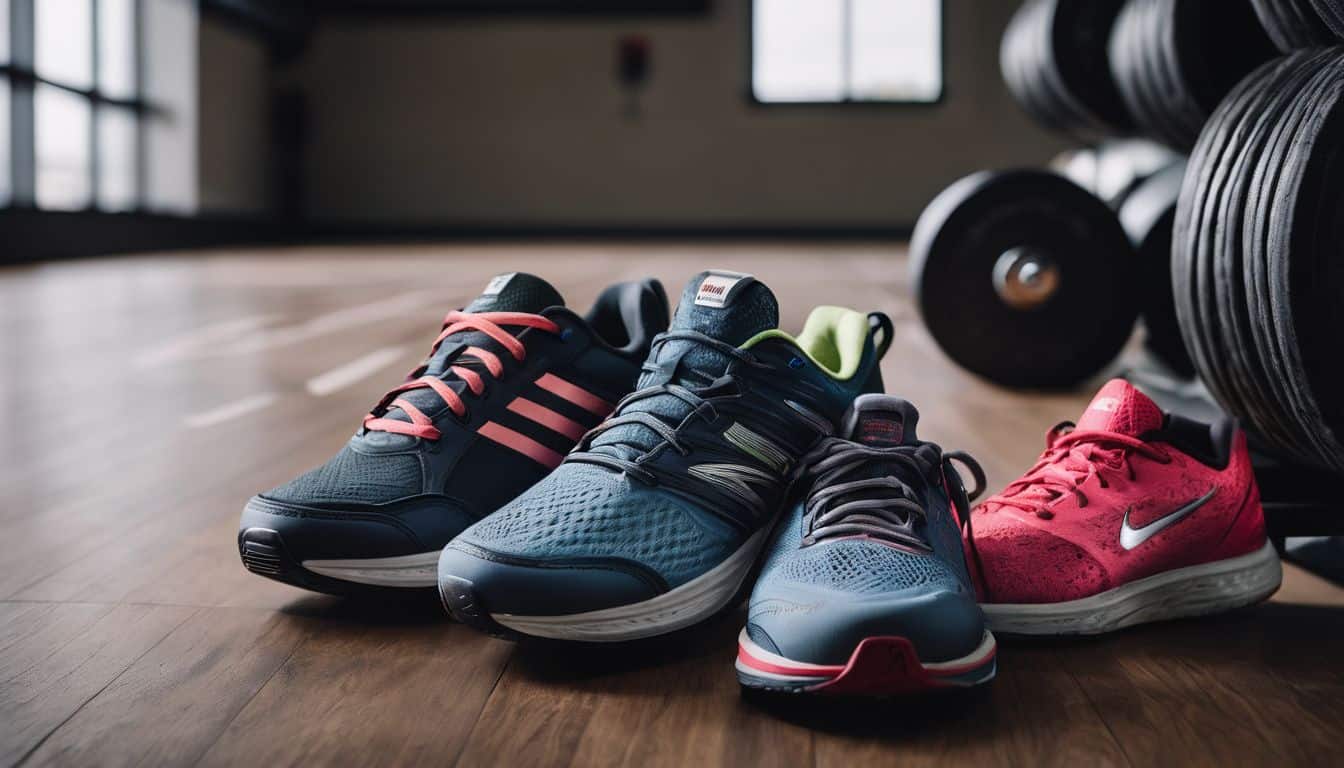As I lace up my faithful running shoes, readying myself for a gym workout, I can’t help but pause. “Is it okay to use these same shoes for training too?” Familiar? It’s a question that has replayed in my mind many times as I ponder the significance of suitable footwear in injury prevention and boosting performance.
And it isn’t just me—scientific research confirms that wearing incorrect shoes heightens risk factors related to foot and leg injuries. So let’s tackle this shoe dilemma head-on: what really separates running from training shoes? What are their potential risks and benefits on your fitness journey? Let’s step forward into new knowledge together.
On your marks, get set..read!
Key Takeaways
- Running shoes and training shoes serve different purposes and have distinct designs. Running shoes are best for long runs, while training shoes are ideal for gym workouts or exercises that involve lateral movements.
- When choosing running shoes, look for features like a comfortable drop, thick midsole, proper fit, lightweight yet durable material, and supportive design.
- When selecting training shoes, consider cushioning for impact absorption, grip and traction for quick lateral movements, support for various types of exercises, stability for jumping or weightlifting activities, and durability to withstand intense workouts.
- While running shoes can be used for some types of training exercises that require comfort and flexibility in the forefoot, it is recommended to invest in proper training shoes if you regularly engage in a variety of workouts to ensure better performance and reduce the risk of injuries.
The Difference Between Running Shoes and Training Shoes
Running shoes and training shoes have distinct purposes and designs, serving different needs during physical activity.
Purpose and design
Running shoes and training shoes are not the same. They look different because they do things differently. You see, running shoes are built for long runs. Their design gives them lots of push and softens each step you take.
Training shoes, on the other hand, work better for gym time or workout classes. They give your feet tight hold, so you can move fast in all ways. This is important when you do exercises that make you jump side to side or front to back quickly!
When to wear each type of shoe
You put on running shoes for a jog or race. They give your feet the right help when you move in a straight line. But, if your workout has many different moves, training shoes work best.
Their design lets you move side to side with ease.
Some gym workouts need both front-to-back and side-to-side steps. For these activities, go with training shoes as they have lower heel-to-toe drops than running shoes which gives you more balance.
Do not wear running shoes when lifting heavy weights because their stiff soles may cause harm.
Key features to look for in running shoes
The right pair of running shoes can make all the difference. Here are some features to look for:
- Look at the drop in the shoe. This is where your foot feels most comfortable and it’s based on your own body.
- Check out the midsole, it should be thick and comfy to help you run better.
- Running sneakers should fit well and not be too tight or too loose.
- The material of athletic footwear matters too. It has to be light but strong enough for running.
- Think about shoe design as well. Trainers for running need to have a good shape to support your feet while you run.
- Lastly, always try jogging shoes before you buy them.
Key features to look for in training shoes
When choosing training shoes, there are some key features that you should look for:
- Cushioning: Training shoes should provide good cushioning to absorb impact during your workouts.
- Grip and Traction: Look for shoes with soles that have a good grip and traction, especially if you’ll be doing exercises that require quick lateral movements.
- Support: Training shoes should offer support for different types of movements, including side-to-side motions.
- Stability: Look for shoes that provide stability, especially if you’ll be doing exercises that involve jumping or weightlifting.
- Durability: Training shoes should be made with durable materials that can withstand the wear and tear of your workouts.
Can I Use Running Shoes For Training? – A Detailed Analysis

As a running enthusiast, you may be wondering if you can use your running shoes for training. Let’s take a closer look at this question. While running shoes are designed specifically for running, they can also be used for certain types of training exercises.
Running shoes usually have good cushioning and shock absorption, which provide comfort and support during high-impact activities like jumping or plyometrics. They also offer flexibility in the forefoot, allowing for natural movement.
However, it is important to note that running shoes may not provide the same stability and lateral support needed for certain training exercises such as weightlifting or agility drills.
Training shoes are specifically designed with these activities in mind, offering features like a wider base and firmer midsole to enhance stability and prevent injuries.
In conclusion, while you can use your running shoes for some types of training exercises, it is recommended to invest in proper training shoes if you regularly engage in a variety of workouts.
This will help ensure better performance, reduce the risk of injuries, and provide the specific support needed for different types of movements.
Key Words: athletic footwear, exercise shoes
Potential Risks of Using Running Shoes for Training
Using running shoes for training can lead to a lack of stability and support, limited traction, potential discomfort, decreased performance, and an increased risk of injuries.
Lack of stability and support
I want to share some important information about the potential risks of using running shoes for training. One of the main concerns is the lack of stability and support that running shoes may provide during certain training activities.
Unlike training shoes, running shoes are designed specifically for forward motion and cushioning while running. This means they might not offer enough stability or support when you’re doing exercises that involve lateral movements or quick changes in direction.
This can increase your risk of injuries such as sprained ankles or twisted knees. It’s crucial to wear proper training shoes that provide the stability and support needed for your specific workouts to help keep you safe and prevent potential discomfort or setbacks in your training journey.
Limited traction
When using running shoes for training, one important aspect to consider is the limited traction they provide. Running shoes are designed with a focus on forward motion and may not offer the necessary grip and flexibility required for different training activities.
This lack of traction can affect your biomechanics while performing lateral movements or quick changes in direction, potentially leading to decreased performance and an increased risk of injuries.
It’s crucial to choose the right footwear that provides sufficient traction based on the specific movements and activities involved in your training routine.
Potential for discomfort and decreased performance
Using running shoes for training can potentially lead to discomfort and decreased performance. When you run, your feet need proper support and stability to prevent injuries and maintain optimal performance.
Running shoes are designed specifically for running, with features like cushioning and shock absorption that are tailored to the repetitive impact of running. However, when it comes to training activities like weightlifting or cross-training exercises, running shoes may not provide the necessary support or stability.
This can result in discomfort during these exercises and hinder your overall performance. It’s important to invest in proper training shoes that offer the right amount of support and cushioning for each activity you engage in during your training sessions, reducing the risk of discomfort and maximizing your potential for success.
Increased risk of injuries
Using running shoes for training can increase the risk of injuries. This is because running shoes are designed specifically for running, and may not provide the necessary support and stability needed for other types of training activities.
When you train with running shoes, you might experience foot alignment issues, which can lead to muscle pulls, tendon strains, or even sprained ankles.
Another potential risk of using running shoes for training is inadequate support and cushioning. If your shoes don’t have enough support or cushioning in certain areas, you could end up with blisters or shin pain during your workouts.
It’s important to wear appropriate training shoes that offer the right level of comfort and protection for your specific activities.
Additionally, wearing old or worn-out running shoes can also increase the risk of injuries. As these shoes lose their ability to absorb shock effectively over time, they may put extra stress on your joints during high-impact exercises.
Benefits of Using Proper Training Shoes
Using proper training shoes can provide enhanced performance and safety during your workouts, improved support and cushioning for specific exercises, and reduce the risk of foot and leg injuries.
Discover why investing in the right footwear is essential for maximizing your training potential. Read more to find out!
Enhanced performance and safety during training
Proper training shoes are essential for enhanced performance and safety during your workouts. By selecting the right footwear, you can minimize the impact of each step and decrease the risk of injury.
Good shoes provide better support, cushioning, and stability – all of which contribute to improved comfort and overall performance. They can also prevent injuries during sports activities by offering optimal protection to your feet and legs.
So, make sure to choose the right training shoes to ensure safety and optimize your workout experience.
Improved support and cushioning for specific exercises
Proper training shoes provide better support and cushioning for specific exercises. When you’re doing different activities during your workouts, like jumping or lateral movements, you need shoes that can give you the right kind of support.
Training shoes are designed with features that offer stability and shock absorption to help enhance your performance and reduce the risk of injuries. Whether it’s lifting weights, doing plyometric exercises, or engaging in high-intensity interval training (HIIT), having proper training footwear will give you the support and comfort you need to perform at your best while minimizing the strain on your feet and legs.
So, investing in a pair of good training shoes is definitely worth it!
Reduced risk of foot and leg injuries
Wearing proper training shoes can greatly reduce the risk of foot and leg injuries during running and training. These shoes provide enhanced support and cushioning, which helps to absorb shock and protect your feet from impact-related injuries.
They are designed with features that promote stability and balance, reducing the chances of twisted ankles or sprains. Training shoes also offer better traction, allowing you to maintain grip on different surfaces and minimizing the risk of slipping or falling.
By choosing the right footwear for your activities, you can significantly decrease the likelihood of experiencing painful foot and leg injuries while staying active.
Factors to Consider When Choosing Shoes for Training
Consider the type of training activities, your foot and arch type, the fit and comfort of the shoes, as well as brand and budget considerations.
Type of training activities
I want to focus on the different types of training activities that you might be doing. When it comes to choosing the right shoes for your training, it’s important to consider the specific type of activity you will be engaging in.
There are various types of training shoes available, such as athletic shoes, fitness footwear, exercise shoes, sports shoes, workout shoes, and gym shoes. It’s essential to choose a pair that is suitable for your particular activity.
For example, if you’re going jogging or running on pavement or other hard surfaces, road running shoes would be the best option. On the other hand, if you plan on off-road running or trail running on uneven surfaces like dirt trails or rocky terrain, then trail running shoes with better traction and stability features would be more appropriate.
And if your workouts involve a variety of exercises that require forward, lateral, and backward movements like weightlifting or circuit training at the gym then cross-training footwear designed specifically for those movements may suit you best.
Foot and arch type
To choose the right shoes for training, it’s important to consider your foot and arch type. There are three types of feet: flat foot/low-arch, neutral arch, and high arch. Your foot type can affect how you run and what kind of support you need.
For example, if you have flat feet or a low arch, you may need shoes with more stability and cushioning. On the other hand, if you have a high arch, you might benefit from shoes with extra arch support.
Understanding your foot and arch type can help ensure that you find the best-fitting shoes for your training needs. So don’t forget to consider this factor when choosing your next pair of training shoes!
Fit and comfort
Fit and comfort are crucial factors to consider when choosing shoes for training. As a running enthusiast, I know how important it is to have shoes that fit properly and feel comfortable on my feet.
When the shoes fit well, they provide the necessary support and stability that I need during my training activities. This helps prevent foot and leg injuries, allowing me to perform at my best while staying safe.
Additionally, having comfortable shoes can also enhance my overall performance by reducing discomfort and distractions during workouts. So, remember to prioritize fit and comfort when selecting your training shoes for a better training experience.
Brand and budget considerations
When choosing shoes for training, brand and budget considerations play an important role. It’s natural to have preferences when it comes to brands, as some are known for their quality and performance.
However, it’s crucial not to overlook other factors such as fit, comfort, and durability. While a popular brand may offer good options, there are also affordable alternatives that can provide the necessary support and features you need for your training activities.
By considering both brand reputation and your budgetary constraints, you can find the right pair of training shoes that meet your needs without breaking the bank.
Conclusion
In conclusion, it is not recommended to use running shoes for training. While they may be comfortable and suitable for running, they lack the stability and support needed for other types of workouts like weightlifting or HIIT.
Investing in proper training shoes will enhance your performance, keep you safe from injuries, and provide the necessary support for different exercises. So, choose the right shoes for each activity to get the best results!
FAQs
1. Can I use running shoes for training?
Yes, running shoes can be used for training as they provide cushioning and support, which are essential for various types of physical activity.
2. What is the difference between running shoes and training shoes?
Running shoes are designed specifically for forward motion while training shoes are more versatile and suitable for a variety of exercises that involve lateral movements, jumping, and weightlifting.
3. Can I wear running shoes for strength training?
While running shoes can provide some level of support during strength training, it’s best to wear specialized lifting or cross-training shoes that offer better stability and grip.
4. Are there any disadvantages to using running shoes for training?
Using running shoes exclusively for all types of training may lead to increased wear and tear on the shoe’s sole due to different movement patterns in activities like weightlifting or high-intensity interval workouts.
5. Should I invest in separate pairs of running and training shoes?
Investing in separate pairs of running and training shoes is recommended if you regularly participate in both activities as it ensures optimal performance, comfort, and longevity of the footwear.






Leave a Reply